Abstract
Study design:
Reviewing documents about Lord Admiral Nelson's wound inflicted at the Battle of Trafalgar and studying the collected data in connection with ballistics and human anatomy.
Objectives:
Attempting to find out the actual cause of death of Lord Nelson as soon as 4 h postinjury by a musket ball.
Setting:
United Kingdom.
Methods:
(1) Review of the original report of Mr W Beatty, Lord Nelson's surgeon, on his examination of His Lordship's wound. (2) Investigating the course of the musket ball in connection with an atlas of human anatomy. (3) Investigating the course of the musket ball on a cadaver by RP (one of the authors). (4) Reviewing modern medical literature.
Results:
The report of Mr Beatty suggested that division of a large branch of the pulmonary artery was the cause of Lord Nelson's early death. Assuming the left pulmonary artery was injured, anatomical studies based on atlases and dissection on a cadaver failed to support a simple straight-line course of the musket ball that could have divided the artery and damage the spinal cord on its path forward.
Conclusion:
The question remains open as to how the musket ball following a relatively straight-line trajectory by entering the body at the acromion, could have divided the left pulmonary artery and damaged the spinal cord later in its course. The mechanism needs further investigation.
Similar content being viewed by others
Log in or create a free account to read this content
Gain free access to this article, as well as selected content from this journal and more on nature.com
or
References
Death/Burial. www.aboutnelson.co.uk/death.htm (old version).
Death/Burial. www.aboutnelson.co.uk/death.htm (updated version).
Patrick UW . Handgun Wounding Factors and Effectiveness, Firearms Training Unit, FBI Academy, 14 July, 1989. http://www.pgpft.com/hgwfe.htm.
Dwight WR . Recovery of bullets from high-speed ammunition. Amer J Police Sci www.saf.org/LawReviews/Rife1.html.
Acknowledgements
We thank Dr Colin S White, National Maritime Museum for providing us with the report of Lord Nelson's surgeon, Mr W Beatty, on His Lordship's wound that made this project possible. We are also grateful to Lady Susan Shakespeare for her advice and support of the project. Thanks also go to Andrew Wainwright, Department of Radiology, Stoke Mandeville Hospital for his painstaking attempts to create a cut through the extremely complex course of the musket ball on CT.
Author information
Authors and Affiliations
Rights and permissions
About this article
Cite this article
Wang, D., El-Masry, W., Crumplin, M. et al. Admiral Lord Nelson's death: known and unknown – A historical review of the anatomy. Spinal Cord 43, 573–576 (2005). https://doi.org/10.1038/sj.sc.3101850
Published:
Issue date:
DOI: https://doi.org/10.1038/sj.sc.3101850



